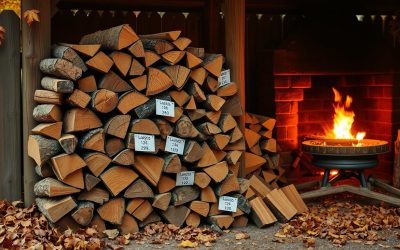When we choose heating with firewood, we often encounter several common challenges that can impact our experience. Sourcing quality firewood is frequently a primary concern for many homeowners, as access to reliable suppliers can determine the efficiency and comfort of our heating methods. We’ll dive into the distinctions between seasoned and kiln-dried firewood and how these factors can influence our choices. Additionally, understanding the nuances of firewood delivery and storage can pose hurdles that require our attention. By recognizing these challenges, we can take steps to enhance our firewood heating experience and enjoy the warmth it provides.
Key Takeaways
- Sourcing quality firewood is essential for effective heating.
- Understanding seasoned versus kiln-dried firewood impacts our choices.
- Reliable firewood delivery is a common concern for many homeowners.
- Maintaining an adequate supply of firewood requires planning.
- Storing firewood properly helps in maintaining its quality.
- Identifying sustainable suppliers enhances our firewood sourcing experience.
Sourcing Quality Firewood
When we look to source quality firewood, understanding the types available is crucial. One important option is seasoned firewood, which has undergone a drying process to reduce its moisture content. This ensures better burning efficiency and improved heat output, making it a reliable choice for our heating needs.
Understanding Seasoned Firewood
Seasoned firewood refers to logs that have been cut and left to dry for several months. This process allows the moisture to evaporate naturally, resulting in wood that ignites easily, burns hotter, and produces less smoke. By choosing seasoned firewood, we enhance our fire experiences and promote effective use of our fuel resources.
Choosing Between Kiln-Dried and Seasoned Options
While seasoned firewood is a popular choice, many may consider kiln-dried firewood. This type of wood is processed in controlled environments, allowing for rapid drying and immediate availability. Although it may come at a higher cost, kiln-dried firewood offers convenience for those who want to buy firewood quickly. When weighing the options, we should consider our budget alongside our heating needs.
Finding Sustainable Firewood Suppliers
In our quest for quality firewood, sourcing from sustainable firewood suppliers remains essential. Sustainable practices contribute to the preservation of local ecosystems and ensure the long-term availability of firewood. We can identify reputable local firewood vendors by looking for those who prioritize responsible sourcing, proper management of forest resources, and transparency in their operations. This way, we make informed decisions while supporting the environment.
Storage and Maintenance of Firewood
Effective storage of firewood plays a critical role in maintaining its quality and usability. By applying the best firewood storage practices, we can minimize issues such as moisture buildup and deterioration, which negatively impact burning efficiency. Understanding appropriate storage techniques is essential for anyone who relies on firewood for heating.
Best Practices for Storing Firewood
To ensure optimal firewood storage, we should focus on creating an environment that encourages airflow while protecting the wood from the elements. Key practices include:
- Choosing a well-ventilated area that avoids direct contact with the ground.
- Utilizing racks or pallets to elevate firewood, reducing moisture absorption.
- Covering the top of the wood pile with a waterproof tarp or sheet, while leaving the sides exposed for ventilation.
- Avoiding stacking wood against buildings or walls to promote airflow.
Preventing Pests and Mold in Firewood
Preventing pests and mold in firewood is vital for maintaining quality. We can adopt several strategies for effective firewood maintenance:
- Regularly inspecting stored firewood for signs of insect activity or mold growth.
- Utilizing barriers such as metal screens to deter pests.
- Maintaining dryness by ensuring firewood is stored in a location that does not trap moisture.
- Implementing a rotation system, using older wood before newer supplies to reduce the risk of mold in firewood.
Conclusion
As we navigate the challenges of using firewood for heating, it becomes increasingly clear that the quality of our firewood significantly impacts our overall experience. By prioritizing the sourcing of high-quality seasoned wood, we can ensure that our fires burn longer and more efficiently. Our discussions highlighted the importance of understanding the differences between kiln-dried and seasoned firewood, enabling us to make informed decisions when selecting the best option for our homes.
Effective firewood use also extends to proper storage and maintenance strategies. We have learned the best practices for keeping our firewood dry and preventing pests and mold from becoming a nuisance. By addressing these concerns, we can mitigate the common issues that plague many homeowners and enjoy the warmth and ambiance that firewood offers.
Ultimately, overcoming firewood issues necessitates a proactive approach. As we implement the insights gleaned from our discussion, we can enhance our firewood heating experience and create a more efficient and enjoyable environment in our homes. For further assistance or to explore quality firewood delivery options, feel free to contact us at Demo Content via phone at (888) 555-1212.
FAQ
Q: What is the difference between seasoned firewood and kiln-dried firewood?
A: Seasoned firewood has been dried naturally over time, typically resulting in moisture content between 15-20%, which provides better burning efficiency. Kiln-dried firewood, on the other hand, is dried in a controlled environment, often reaching lower moisture levels, which allows it to burn hotter and with less smoke, but can come at a higher price.
Q: How can I ensure that I am buying quality firewood?
A: To buy quality firewood, look for seasoned firewood with low moisture content, and check for visible signs of splitting or cracks. Always choose a reliable local firewood supplier known for their commitment to sustainable firewood practices. Ask about their drying processes to further ensure you’re getting the best firewood available.
Q: What are the best practices for storing firewood?
A: The best practices for storing firewood include placing it off the ground to prevent moisture buildup, stacking it in a way that promotes good airflow, and covering it to protect from rain and snow while ensuring ventilation. A dry, open area is ideal for maximizing the longevity and quality of your firewood.
Q: How can I prevent pests and mold in my stored firewood?
A: To prevent pests and mold in firewood, regularly inspect your stored wood for signs of infestations. Keeping your firewood dry is key, so ensure your storage area has good airflow. Additionally, using barriers against the ground and positioning your firewood in a sunny place can help deter mold and pests.
Q: Can I have firewood delivered to my home?
A: Yes, many suppliers offer firewood delivery services. When choosing a delivery service, ensure they provide quality seasoned or kiln-dried firewood and inquire about their delivery area to ensure you can receive service at your location.
Q: Why is sourcing sustainable firewood important?
A: Sourcing sustainable firewood is crucial for maintaining local ecosystems and ensuring the long-term availability of firewood resources. Sustainable practices help to minimize the impact on forests and contribute to a healthier environment, making it a responsible choice for homeowners.



